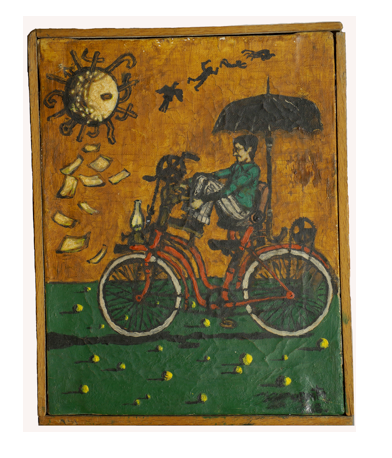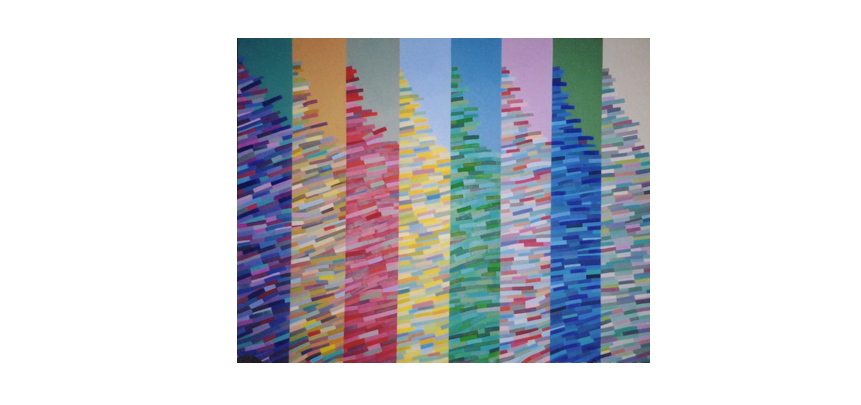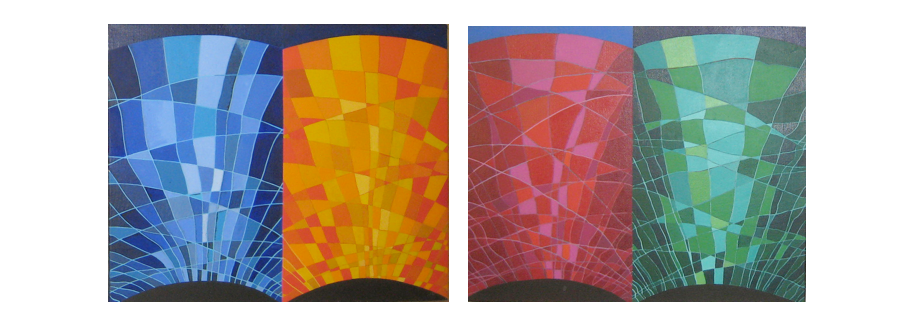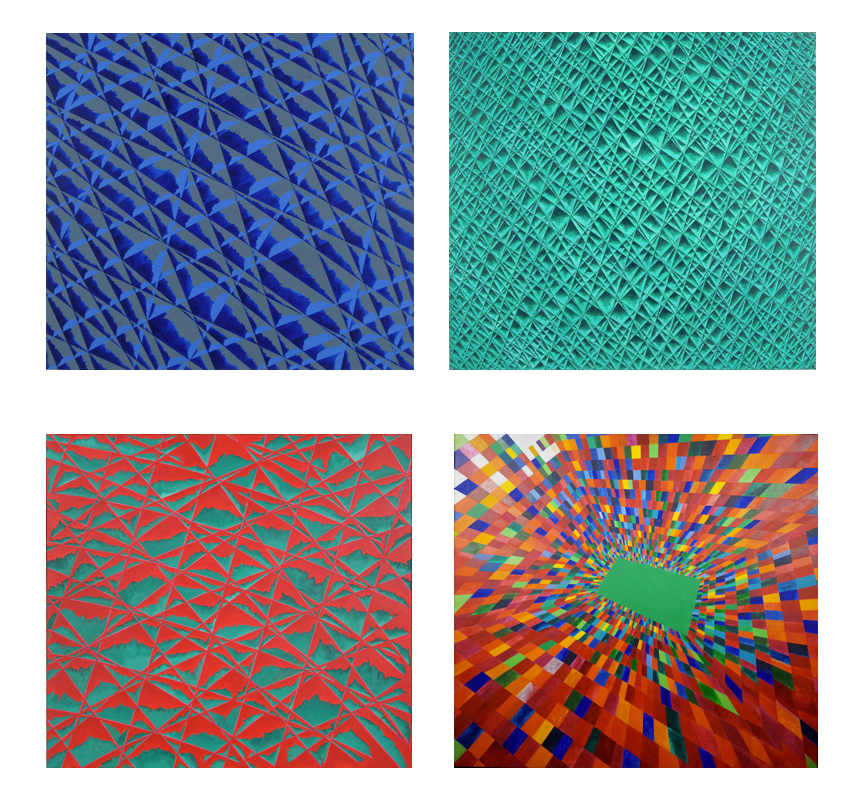Belgrade, 15. october 1950 – 28. october 2008.
Đurović graduated from the Academy /Faculty of Fine Arts in Belgrade, Department of Painting, in 1974 and completed his postgraduate studies in 1978 with Professor Stojan Ćelić.
He was born in Belgrade in 1950 and died in 2008 and his whole life was dedicated to art. He lived in Belgrade, New York (in the late eighties) and London (from 2001 to 2005), and did not have many solo exhibitions. Between 1976, the year of his first solo show of paintings and drawings organised in the Kolarac Gallery, and 2005, when he had his last solo (paintings) in the Gallery of the Association of Serbian Artists (ULUS), he had five exhibitions: in 1979 in the Gallery of Graphic Artists (drawings), in 1981 in Nikšić (paintings and drawings), in 1986 in the Kolarac Gallery (paintings), in 1993 in the Gallery of Graphic Artists (collages), and in 1999 in the ULUS Gallery (paintings), together with Zoran Grebenarović and Mladen Mićunović.

From 1973 he participated in a number of group exhibitions in Yugoslavia and Serbia, in France, The Netherlands and Great Britain and received several important awards: the October Salon award for painting in 1989 and in 1986 was rewarded by the City of Belgrade Cultural Department for the best solo exhibition in the Kolarac Gallery.
He painted, drew, made collages, helped in the execution of important mosaics; general design, magazine and book design were also within the scope of his activities. He used oil paints, acrylic, combined techniques, coloured pencils.
In the late 1980s he worked on the mosaic for the Serbian National Theatre in Novi Sad and the Radio-television building in Košutnjak in Belgrade.

He was a member of the Association of Serbian Artists (ULUS) from 1975.
Đurović did not just paint, but he thought about his profession. In his recently discovered notes we find: „My paintings are the result of a profound and systematic observation of things that surround me. Therefore, the chosen motif is separated from the whole to which it belongs and when transposed onto the canvas it offers the unexpected, because we are used to see it together with other elements or happenings that accompany it and with which it makes up an entity that we recognise and remember… Objects separated from the whole acquire new qualities, new characteristics. When one considers those relations one could speak about these paintings as a view of the world. The surrounding world we pass every day without noticing it.“

In the catalogue for exhibition RADIVOJE ĐUROVIĆ, OB BICYCLE TO A MODERN CITY, Bojan Burić wrote:
Radivoje Đurović belongs to the generation of young people who studied at the Academy of Fine Arts in Belgrade (Faculty, after 1973) in a creative atmosphere that generated a number of artists who made their city in the 1980s a true metropolis of art. Although it seemed then that two exclusive poetics were dominant in the School, such as poetic or symbolic realism and abstraction – classifying students in a simplified way into rationalists and intuitivists – the creative potential lay in those who carefully fostered and retained their individuality. Radivoje Đurović was one of them and he was able to use in the best way the fact that he attended the prestigious class of Professor Stojan Ćelić and learned the methodology that helped him to build and improve his own sensibility and inform his own visual reflections. His creative self combined intelligence and intuition, asceticism and concision with creative hedonism that would suddenly break into flames of colouristic fireworks. During his maturation into a personally striking artist, discreet but persistently present on the artistic scene of the time, Radivoje Đurović understood his professor’s lessons: he applied them but also found a sovereign articulation of his own idiom. Very serious and dedicated to his painterly tasks and elaboration of plastic problems, which he recognised as constituents of his painterly world, he did not allow himself to be fascinated by the first successes but worked consistently in order to realise harmony between the minimal means of expression and maximum visual experience and effectiveness. He created his drawings and early painting with his chosen reduced syntax, with just the line or delicate hatching, monochromatic surfaces, a radical choice of confronted sharp geometric forms or curvatures, soft contours that define the relief. His narratives came from his immediate surroundings: the view from the window of his room or studio at the Academy or objects of profane existence – and in their relations he was not looking for symbolic meanings but for visual, plastic values and the ways they made up compositional rhythms.

One of the key goals the artist placed before himself was to overcome the resistance of the coloured pencil which seismically recorded deformations of the geometric forms as reinforcements of the dynamics of movement within the scene and a gradual bending of space suggestively turning into fluid. All this is evident in his drawings where he worked out of what would certainly happen in paintings. The view as theme, the relationship between fragments and the wholeness of a scene, are always present as motives in Đurović’s works and represent his desire to harmonise the real and the abstract, as the place where the material and spiritual meet. Drawings/miniatures assume view finding, focusing and establishing a distance towards the seen and recorded in the depth of the artist’s and our glance. Therefore their real existence is drawn into the depth of the emptiness of the space, a white canvas or white passepartout encircling the consistence of the drawn scene of strict essentiality.



In the eighties, when we finally achieved the temporal synchronisation with European and global artistic happenings, and the time of numerous creative poetics, Radivoje Đurović produced paintings with recognisable appropriations of op-art, pattern painting and neo-geo tendencies. In those years he was at the same time engaged in design, not only by implementing his high visual culture for “useable purposes” but with possible displacement of the decorative into another segment of creative activity – to get liberated from the formalism of modernity and keep the freshness and purity of his painterly expression.

A precious experience was his engagement in the execution of mosaics because the work called for concentrated thinking about the relationship of fragments and the whole. The setting of particular pieces that endow the composition with meaning and the objectness of the mosaic image led him to a creative adventure of the production of collages and in the early nineties he made an exceptionally good cycle of works in this technique. They represent only one period in Đurović’s opus, one segment of his intensive engagement in an emancipated consideration of collages but also his overall re-examination of the limits of his painting in order to keep it in the spheres of pure pictorial representation. By cutting ribbons from different kinds of paper, mostly printed, Đurović created mono-elements painted in diverse colours as constitutive elements of his collages. A module is materialised colour where the artist makes interventions with the brush in order to create coloured accents. In the series of pictures/collages Stadiums Đurović set these modules/ribbons into the rows of the auditorium and in that way turned them in coloured slices of the body of the stadium. By laying the coloured ribbons in a geometric order the artist controls their visual cacophony and creates fields of different visual dynamics and energy effectiveness. By disturbing the strict geometric order of modules Đurović deforms the two-dimensionality of the scene and secures the objectness of that collage. This “systemic plastics” enables the movement from two-dimensionality to an object, by means of the structure of monads. A haptic space is realised and at the same time the front plane of the plastic happening is preserved. In the margins of some of the collages there are traces of extraction from the surface, thus securing in advance the depth of the happening in the lowest zone, where the diagonally arranged multi-coloured paper ribbons are crossed and fastened to the support only in several places. Seized and captivated by the texture, the shadows give specific dynamics to the scene. The optical polyvalance of these works, achieved primarily by different intensities of rostrum fields and their rhythm, led Đurović into the process of painting where the visual effects were directly related to the reflections and refractions of light in/on the painted surface. In his works made during the last ten years of his life, when he painted only stylised urban scenes, the main subject matter in fact was the phenomenon of colour radiation, his long lasting preoccupation.

The series of almost monochromatic paintings produced between 2001 and 2006 is an extraordinary outcome of his overall researches and media adventures. The paintings emanate colouristic soundness and resonance of colour/s by restrained vibrant lineal structure; their gentle and accidental slippage from the geometric order and discreet tonal nuances deform and influence the suggested relief of these paintings. Executed with “a jeweller’s precision” the facets of these painted surfaces radiate a painted passion and satisfaction that rehabilitate painting as the medium, which survives despite all theoretical hypotheses…
The following sentence is found among Đurović’s rare notes:
“My paintings are dedicated to the modern city, to segments of a modern city; every stroke seems frighteningly out of control and the next one deadly precise…”



Od 1973. učestvuje na velikom broju kolektivnih izložbi, u Jugoslaviji i Srbiji, u Francuskoj, Holandiji i Velikoj Britaniji a dobio je i nekoliko značajnih nagrada: nagradu Oktobarskog salona za slikarstvo dobio je 1989, a 1986. nagradu SIZ-a kulture Beograda za najbolju samostalnu izložbu slika u Kolarčevom narodnom univerzitetu.
Slikao je, crtao, pravio kolaže a i dizajn, likovna oprema časopisa i knjiga, mu nije bio stran. Koristio je ulje, akrilik, kombinovanu tehniku, olovke u boji.
Krajem sedamdesestih godina XX veka radio je na izradi mozaika u Srpskom narodnom pozorištu u Novom Sadu i u zgradi Televizije na Košutnjaku.
Bio je član ULUS-a od 1975 godine.

Đurović nije samo slikao već je o svom sopstvenom delanju i razmišljao. U skoro otkrivenim beleškama nalazimo: „Moje slike su plod jednog pomnog i sistematskog gledanja stvari koje me okružuju. Tako, odabran motiv izdvajam iz celine kojoj on pripada i prenesen na platno on pruža iznenađenje, jer smo navikli da ga gledamo u određenom sklopu sa ostalim elementima ili zbivanjima koja ga prate i sa kojima predstavlja celinu po kojoj ga prepoznajemo i pamtimo… Predmeti izdvojeni iz celine dobijaju nove kvalitete, nove karakteristike. U tim relacijama se o ovim slikama može govoriti kao o pogledu na svet. Na svet koji nas okružuje i pored koga prolazimo svaki dan, a ne primećujemo ga.“
U katalogu za izložbu RADIVOJE ĐUROVIĆ, BICIKLOM U MODERAN SVET Bojana Burić piše:
Radivoje Đurović pripada generaciji umetnika koji su studirali na Akademiji likovnih umetnosti u Beogradu (od 1973. Fakultetu), u kreativnoj atmosferi koja je iznedrila brojne stvaraoce, a koji su učinili osamdesetih godina svoj grad istinskom umetničkom metropolom. Iako se činilo da na samoj Školi dominiraju dve izrazite poetike, kao što je poetski ili simbolički realizam i s druge strane apstrakcija, a što je simplifikovano delilo studente na racionaliste i intuitivce, stvaralački potencijal se nalazio u onima koji su svoju individualnost brižljivo negovali i očuvali. Među njima je svakako Radivoje Đurović, koji je svoje školovanje u prestižnoj klasi profesora Stojana Ćelića na najbolji mogući način iskoristio da se metodološki osposobi, da gradi i neguje sopstvenu osetljivost i da formira svoje vizuelno mišljenje. U njegovoj stvaralačkoj ličnosti bile su spojene inteligencija i intuitivnost, askeza i jezgrovitost iskaza sa stvaralačkim hedonizmom, koji bi iznenada buknuo i rasplamsao se u kolorističkom vatrometu. Tokom izrastanja u personalno vrlo markantnog umetnika, diskretnog, ali postojanog prisustva na tadašnjoj likovnoj sceni, Radivoje Đurović umeo je da razume pouke profesora, da ih primeni, ali i da suvereno pristupi artikulaciji svog jezičkog idioma. Veoma ozbiljan i posvećen svom slikarskom poslu i elaboraciji plastičkih problema, koje je prepoznao kao konstituente svog slikarskog sveta, nije dozvolio da ga ponesu prvi, uspešni rezultati, već je uporno radio na ostvarenju harmonije između minimalističkih izražajnih sredstava i maksimalnog vizuelnog doživljaja i učinka. Izabranom redukovanom sintaksom, samo linijom i delikatnom šrafurom, ili monohromnim površima, radikalnim izborom sučeljenih oštrih geometrijskih formi i zaobljenja, mekih kontura koje definišu reljef, stvarao je svoje crteže i rane slike. Njegovi narativi su iz najneposrednijeg okruženja: pogled kroz prozor sobe ili ateljea na Akademiji, predmeti profane egzistencije u čijim odnosima ne traga za simboličkim značenjima, već za likovnim, plastičkim vrednostima i njihovim uodnošavanjem u kompozicione ritmove.

Savladavanje otpora drvene olovke u boji, koja seizmografski beleži deformaciju geometrijskog oblika kao pojačavanje dinamike pokreta u prizoru i postepeno zakrivljavanje prostora koji sugestivno postaje fluid, očigledno je na crtežima, razradi onoga što će se tek izvesno desiti u slici, bio je jedan od ključnih ciljeva koje je ovaj umetnik sebi postavio… Tematizacija pogleda, odnosa fragmenta i celovitosti prizora, koji su uvek prisutni kao motiv na Đurovićevim radovima, predstavlja težnju ka usklađivanju realnog i apstraktnog, kao mesta na kojem se susreću materijalno i spiritualno. Crteži/minijature podrazumevaju viziranje, fokusiranje i uspostavljanje distance prema viđenom i zabeleženom u dubini umetnikovog i našeg pogleda. Stoga je njihova realna egzistencija uvučena u dubinu praznine prostora, belog papira/paspartua koji zaokružuje konzistentnost iscrtanog prizora, stroge elementarnosti.

Tokom osamdesetih, kada smo se vremenski konačno sinhronizovali s evropskim i svetskim umetničkim događajima, a u doba pluralizma stvaralačkih poetika, Radivoje Đurović se prepoznaje po slikama koje na najbolji mogući način aproprijaciski razmatraju iskustva opart-a, pattern painting-a, sve do neogeo tendencija. Tih godina, on se istovremeno bavi i dizajnom, ne samo implementiranjem svoje visoke vizuelne kulture u „upotrebne svrhe” već i mogućnošću da se izazov dekorativnog deložira u drugi segment stavralaštva; da se oslobodi formalizma modernizma i tako očuva svežinu i čistotu svog slikarskog izraza.

Rad na izvođenju mozaika je takođe bio dragoceno iskustvo, koje je podrazumevalo koncentrisano razmišljanje o odnosu fragmenata i celine. Slaganje partikula koje daju smisao kompoziciji, kao i objektnost mozaičke slike, odvelo ga je ka stvaralačkoj avanturi rada na kolažima a što je rezultiralo, početkom devedesetih, izuzetno uspešnim ciklusom dela izvedenih ovom tehnikom. Oni ne predstavljaju u Đurovićevom opusu samo jedan period ili segment njegovog intenzivnog bavljenja emancipovanim kolažnim mišljenjem, već i sveukupno preispitivanje granica sopstvenog slikarstva, da bi ga očuvao u sferama čiste pikturalnosti. Isecajući trake od papira, različitog porekla, uglavnom štampanog, Đurović je stvorio monoelement različite obojenosti kao gradivni element svoje kolažne slike. Modul je materijalizovana boja na kojoj autor interveniše četkom, dodajući bojene akcente. U seriji slika/kolaža Stadioni Đurović slaže ove module/trake u redove gledališta koji postaju bojeni režnjevi tela stadiona. Slaganjem trake monoelemenata u geometrizovani poredak, autor drži pod kontrolom njihovu vizuelnu kakofoničnost, stvarajući polja različite vizuelne dinamike i različitog energetskog dejstva. Ugrožavanjem strogog geometrijskog poretka modula, Đurović je deformisao dvodimenzionalnost prizora i obezbedio objektnost takvog kolaža. Ovakva „sistemska plastika” omogućava izlazak iz dvodimenzionalnog do predmeta, strukturom monada. Stvara se haptički prostor a istovremeno se čuva prednji plan plastičkog događaja. Poneki od kolaža po marginama nose trag „vađenja” iz površi i time unapred obezbeđuju dubinu događaja koji se ostvaruje u poslednjoj zoni, gde se ukrštaju dijagonalno raspoređene raznobojne papirne trake, fiksirane za podlogu samo u pojedinim tačkama. Senke, zahvaćene i zarobljene teksturom, vizuelno dinamizuju ceo prizor. Optička polivalentnost ovih radova, postignuta pre svega različitim intenzitetom rasternih polja i njihovim ritmom, uvela je Đurovića u proces slikanja koji, po svojim vizuelnim efektima, problematizuje refleksije i refrakcije svetlosti u/na slikanoj površini. Fenomen radijantnosti boja, koji ga je godinama zaokupljao, tematizovan je kroz stvaralaštvo poslednje decenije njegovog života, kada se u potpunosti prepušta slikanju stilizovanih urbanih sekvenci.

Serija skoro monohromnih slika nastalih u periodu od 2001. do 2006. predstavlja izvanrednu rezultantu svih njegovih istraživanja i medijskih avantura, odiše kolorističkim zdravljem, zvučnoću boja/boje suspregnutom vibrantnom linearnom strukturom, koja blagim, akcidentnim iskliznućima iz strogo geometrijskog poretka deformiše i diskretnim valerskim različitostima utiče na sugestiju reljefnosti ovih slika. Izvedene „juvelirskom preciznošću”, fasete ovih slikanih površina isijavaju slikanu strast i zadovoljstvo koje rehabilituje slikarstvo kao medij koji uprkos svim teoretskim hipotezama opstaje…
U retkim zabeleškama Radivoja Đurovića nailazimo na rečenicu:
Moje slike se bave modernim gradom, segmentima modernog grada. Tu svaki potez izgleda zastrašujuće nekontrolisan a svaki sledeći smrtonosno precizan…




ZEPTER MUSEUM
Knez Mihailova street 42,
11000 Belgrade, Serbia
+ 381 (0) 11/ 328 33 39
+ 381 (0) 11/ 33 00 120
ENTRANCE FEE
200 RSD, 100 RSD, free
Opening hours
- Tuesdays, Wednesdays, Thursdays and Fridays
- 12 noon – 8 pm
- Saturdays, Sundays
10 am– 8 pm


